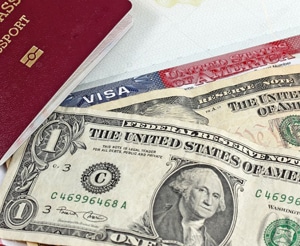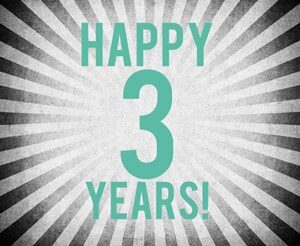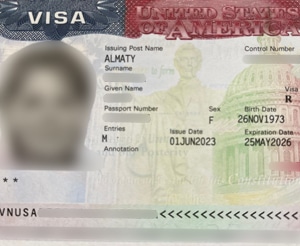ВАЖНО С радостью сообщаем, что мы начинаем предварительный прием документов для участия в лотерее Green Card DV-2026! Лотерея Green Card — это ежегодная программа правительства США, которая позволяет людям со всего мира получить вид на жительство в Америке. Участие бесплатно, но важно правильно подготовить документы и анкету DS-5501. Обратившись в нашу компанию уже сейчас, вы сможете подготовиться без спешки, получить подробные консультации, индивидуальный подход и уверенность, что вашей заявке будет уделено максимальное внимание. Оставить заявку на участие в ежегодной лотерее Green Card DV-2026 можно по ссылке.
Аппликанты часто задаются вопросом – какую визу в США проще всего получить? Сразу должны сказать, что определенного ответа здесь нет. У каждой категории американской визы есть свои нюансы, требования и условия оформления. Кроме того, решение выносится индивидуально – в соответствии с ситуацией конкретного заявителя. Однако можно отметить, что некоторые типы визы США открывают проще. Это значит, что в Посольстве к аппликантам предъявляют не такие строгие требования, пакет документов может быть не очень объемным, интервью проводится более формально, без лишних расспросов. Ниже мы рассмотрим основные категории, чтобы выяснить – какую визу США легче получить (в сравнении с другими). Также в нашей статье мы рассказываем заявителям, на что нужно обратить внимание для успешного оформления.
Туристическая виза (B-2). Кажется, что это самый простой вариант – открыть туристическую визу в Америку. Действительно, требования по документам к заявителям минимальны: достаточно предоставить всего несколько справок. Но при оформлении туристической визы США типа B-2 важно совсем другое. Необходимо убедить консульскую службу в том, что вы не останетесь в Америке и обязательно вернетесь домой. Для этого на интервью нужно предоставить документальные доказательства связей с Россией, а также убедительно рассказать о них устно. Далее решает офицер: он интерпретирует ваши доводы и объявляет – одобрена виза или нет. Увы, часто решение может быть совсем не в пользу аппликанта. Поэтому нужно постараться и представить свою ситуацию максимально простой и прозрачной, чтобы у офицера не возникло сомнений.
Студенческая виза (F-1). В отличие от туристической категории B-2, для получения визы F-1 требуется предоставить целый комплект бумаг. Это приглашение от учебного заведения (письмо о зачислении), финансовые подтверждения, спонсорское письмо, сертификаты о других пройденных курсах и пр. Подготовить все сопроводительные документы для американской визы F-1 бывает непросто. Но в то же время именно документы часто помогают получить одобрение по учебной визе в Посольстве США. Офицеры консульской службы внимательно изучают бумаги аппликанта и принимают их как гарантии – в том, что аппликант действительно едет на учебный курс, в том, что он вернется домой. При оформлении студенческой визы США F-1 заявителей реже подозревают в иммиграционных намерениях. Особенно если речь идет о краткосрочной программе.
Рабочие визы (H-1B, L-1 и другие). Получение рабочей визы в США – это сложный, трудоемкий процесс. Он требует времени, усердия и терпения. В первую очередь у заявителя должен быть работодатель-спонсор из Америки. Он составляет и подает петицию, чтобы пригласить иностранного сотрудника. Помимо этого, требуется собрать пакет документов и пройти личное собеседование. На интервью необходимо доказать, что приглашающая организация действительно нуждается в услугах аппликанта. На первый взгляд, оформить рабочую визу в США очень сложно. Но именно такая, серьезная подготовка с документами и интервью обычно помогает заявителю справиться с процедурой. Если у аппликанта есть соответствующая квалификация и убедительные документы от работодателя из Америки, то, как правило, рабочую визу одобряют.
Визы для исследователей, стажеров, участников программ культурного обмена (Q, J). В данном случае аппликанту необходимо получить приглашение от принимающей стороны в США. Это обязательное условие. Визы типа Q и J открывают под конкретную программу, мероприятие или проект. Заявитель готовит сопроводительные документы и подтверждение спонсорства от приглашающей организации в США. Затем проходит собеседование с офицером консульской службы. Если у аппликанта нет явных причин для отказа, то в основном визу открывают спокойно. Главное – показать офицеру, что вы планируете вернуться домой по окончании программы. Отказы случаются, если офицер подозревает заявителя в иммиграционных целях или если документы оформлены некорректно. В остальных ситуациях визы США типа Q и J выдают без дополнительных сложностей.
Визы для инвесторов и бизнесменов (E, L). Категории американской визы E и L предназначены для ограниченной группы заявителей. Самое главное условие здесь – это наличие значительных финансовых ресурсов и/или серьезного бизнес-плана в США. Визы типа E и L дают множество преимуществ их держателям. В частности, для них существенно упрощаются условия получения грин-карты. Но в тоже время стоит отметить, что требования к заявителям на визу E и L очень строгие. Необходимо подготовить объемный пакет бумаг. В него входят финансовые подтверждения, а также обоснования происхождения инвестиционных средств. Процедура получения данных категорий американской визы может быть очень длительной, все документы тщательно изучаются. А на интервью в Посольстве проводится беседа с множеством уточняющих вопросов.
Подводя итог, мы снова обращаем внимание заявителей: нет «сложной» или «легкой» визы. Нет универсального рецепта, с помощью которого можно легко открыть визу США. Как и нет какой-то конкретной категории, которую точно выдают всем аппликантам. Каждая ситуация индивидуальна. Многое зависит от документов, о того, как заявитель будет вести себя на интервью, как он будет отвечать на вопросы. Важно правильно представить сопроводительные бумаги, а также убедить офицера в том, что вы не планируете остаться в Америке (если это неиммиграционная виза). Также на решение могут влиять текущая политическая ситуация и визовая политика США в целом. Но в любом случае рекомендуется тщательно изучать информацию и при малейших сомнениях обращаться к экспертам. Это поможет повысить шансы на положительный результат.
КАТЕГОРИИ ВИЗЫ




Полезные инструкции и примеры по получению визы США
Оформляя визу США, помните, что это очень сложное мероприятие. Обязательно изучайте проверенную информацию, чтобы разобраться в процедуре. На нашем сайте мы предоставляем множество полезных сведений для аппликантов. Вы узнаете, как выбрать страну оформления визы США, как записаться на интервью и правильно заполнить анкету DS-160. Мы прилагаем подробные примеры и инструктажи по каждому этапу, включая собеседование в Посольстве. Проверьте список вопросов офицера, продумайте свои ответы. Кроме того, важно ознакомиться с частыми причинами для отказа в визе США. Проанализировав их, можно избежать типичных ошибок и увеличить шансы. Все это вы найдете на нашем сайте. Переходите по ссылкам ниже, чтобы успешно оформить визу США. А также следите за новостями: мы всегда размещаем самые важные обновления от Посольства.
Где проще всего получить визу заявителям из России (2024)
Определившись с типом визы, перед заявителями возникает новый вопрос – где ее оформить? В 2024 году получить визу США в России нельзя. Прием по-прежнему закрыт. Россияне выезжают за границу, чтобы пройти собеседование. Но куда именно поехать, где американскую визу получить легче? Сразу отметим, что консульская служба Посольства США использует одни и те же критерии при рассмотрении заявки от аппликанта – в любой стране мира. Т.е. ситуацию заявителя будут изучать примерно одинаково везде. И если есть объективные причины для отказа, то в визе откажут. Но вместе с тем существуют и сопутствующие факторы. Они могут значительно упростить процедуру оформления для граждан России. Во-первых, выбирайте Посольство, в котором работают русскоговорящие офицеры. Тогда интервью будет проходить на русском языке.
Особенно это касается аппликантов, не владеющих английским на высоком уровне. Помните, что вам предстоит разговор с офицером. И если офицер не говорит по-русски, а вы не знаете английского, то ничего не получится. Второй фактор – даты записи. В некоторых странах граждан РФ принимают быстро, а где-то ждать приходится месяцами. Лучше не обращаться в такие Посольства, т.к. нет гарантии, что места появятся. Также старайтесь выбирать популярные направления среди россиян. Здесь уже знакомы с нашими реалиями, документами, типовыми ситуациям. В экзотических государствах возникает больше недопониманий. Ниже мы предлагаем таблицу с основными вариантами оформления визы США в 2024 году. Обращайте внимание на пометку Rus (интервью на русском), а также на количество свободных мест. Это поможет вам сориентироваться.
| Посольства США, возобновившие прием граждан России (26.10.2024 00:29) | |
|---|---|
| Посольство США в Астане (rus) | Места для нерезидентов: ЕСТЬ (см. график) |
| Консульство США в Алматы (rus) | Места для нерезидентов: ЕСТЬ (см. график) |
| Посольство США в Баку (rus) | Места для нерезидентов: МАЛО (см. график) |
| Посольство США в Белграде (rus) | Места для нерезидентов: ЕСТЬ (см. график) |
| Посольство США в Бишкеке (rus) | Места для нерезидентов: ЕСТЬ (см. график) |
| Посольство США в Варшаве (rus) | Места для нерезидентов: ЕСТЬ (см. график) |
| Посольство США в Ереване (rus) | Места для нерезидентов: МАЛО (см. график) |
| Посольство США в Загребе (rus) | Места для нерезидентов: МАЛО (см. график) |
| Посольство США в Иерусалиме (rus) | Места для нерезидентов: МАЛО (см. график) |
| Консульство США в Тель-Авиве (rus) | Места для нерезидентов: МАЛО (см. график) |
| Посольство США в Ташкенте (rus) | Места для нерезидентов: ЕСТЬ (см. график) |
| Посольство США в Тбилиси (rus) | Места для нерезидентов: ЕСТЬ (см. график) |
| Посольство США в Абу-Даби (eng) | Места для нерезидентов: МАЛО (см. график) |
| Консульство США в Дубае (eng) | Места для нерезидентов: МАЛО (см. график) |
| Посольство США в Анкаре (eng) | Места для нерезидентов: МАЛО (см. график) |
| Консульство США в Стамбуле (eng) | Места для нерезидентов: МАЛО (см. график) |
| Посольство США в Берлине (eng) | Места для нерезидентов: ЕСТЬ (см. график) |
| Консульство США в Мюнхене (eng) | Места для нерезидентов: ЕСТЬ (см. график) |
| Консульство США во Франкфурте (eng) | Места для нерезидентов: МАЛО (см. график) |
| Посольство США в Берне (eng) | Места для нерезидентов: ЕСТЬ (см. график) |
| Посольство США в Вене (eng) | Места для нерезидентов: ЕСТЬ (см. график) |
| Посольство США в Джакарте (eng) | Места для нерезидентов: ЕСТЬ (см. график) |
| Консульство США в Кракове (eng) | Места для нерезидентов: ЕСТЬ (см. график) |
| Посольство США в Праге (eng) | Места для нерезидентов: ЕСТЬ (см. график) |
| По состоянию на октябрь 2024: вышеуказанные представительства США за границей принимают заявления на туристические визы B1/B2 от граждан России. Учитывайте, что места для россиян доступны в ограниченном количестве и разбираются мгновенно. Для записи используется бот (нашей собственной разработки). Но даже применения бота для бронирование даты и времени собеседования в Посольстве не может гарантировать сроки оформления визы. Для того, чтобы увидеть календарь с доступными датами в нужной вам стране, нажмите «см. график». | |


 Рейтинг 4,89 (1 160 голосов)
Рейтинг 4,89 (1 160 голосов)










Комментарии (14)
Здравствуйте! Раньше оформлял визу США без собеседования в Москве. Сейчас планирую обращаться за границей. В какой стране легче всего получить визу США? Нужно подавать заявку на ту же визу – B1/B2? Или в связи с особыми условиями для россиян другой тип?
Добрый день, Сергей! Тип визы для туристического путешествия остается прежним – это стандартная категория B1/B2. У российских граждан нет никаких особых условий, в 2024 году к ним не предъявляют никаких особых требований. Все проходит в самом обычном формате (как и раньше). Единственный важный момент связан с личным интервью. Увы, его необходимо проходить всем, даже тем, кто уже в прошлом получал американскую визу.
И проходить собеседование необходимо за границей. Где легче всего получить визу США? Все зависит от ситуации аппликанта. Если у него есть серьезные причины для отказа, то ему откажут в любой стране мира. И наоборот: если все просто и понятно, нет никаких сложностей, то визу могут одобрить практически в любом Посольстве США. Но все же рекомендуется выбирать страны, в которых ведется постоянный прием россиян.
В таких Посольствах часто проводят интервью на русском языке. Отсутствие языкового барьера помогает аппликантам чувствовать себя свободнее и увереннее. Есть возможность спокойно и четко пояснить любой нюанс. К таким странам относится Казахстан (сюда едет большинство россиян), а также Польша, Израиль, Киргизия, Узбекистан. Это наиболее востребованные направления для получения визы в Америку среди российских граждан.
Добрый день! Бывшая жена с ребенком уехали в Штаты по туристической визе. Сейчас оформляют грин-карту по воссоединению с семьей, которую им одобрили. Какие у меня шансы получить туристическую визу США в Мексике? Или в моем случае нужна другая категория? Стоит ли говорить, что моя бывшая жена и мой ребенок в Америке? Смогут ли в Посольстве как-то об этом узнать?
Добрый день, Станислав! В случае туристической поездки в США вам необходимо открывать визу B1/B2. Если же вы решите иммигрировать, то бывшая супруга все равно не сможет оформить для вас соответствующие документы. Программа по воссоединению семьи распространяется лишь на близких членов семьи. Участвовать в ней вы сможете только в качестве отца вашей дочери – когда она будет совершеннолетней. Поэтому сейчас необходимо выбрать другую категорию визы.
Виза в США типа B1/B2 позволяет совершать краткосрочные поездки в Америку с туристическими, гостевыми, деловыми, учебными, спортивными и другими намерениями. Данную визу вы можете использовать, чтобы в дальнейшем навестить дочь. Скрывать ее пребывание в США не следует. Да, в базе данных Посольства есть эта информация. Дочь указывала вас в своей форме DS-160. Возможно, и бывшая супруга отмечала вас (как бывшего мужа) – в анкете есть такой вопрос.
Обратиться за американской визой вы можете в любой стране. Это не запрещается. Проверьте нужное Посольство США на официальном сайте. Но учтите, что в Мексике могут возникнуть трудности с оформлением. Вам будут задавать вопросы – почему вы подаете документы именно здесь, где вы постоянно живете и работаете и т.д. Если у офицеров возникнут сомнения по справкам, уровню дохода и другим российским реалиям, они попросят вас оформить визу через другую страну.
Здравствуйте! Мы всей семьей живем в Грузии. У нас с мужем есть американские паспорта, а у ребенка только российский загранпаспорт. Хотим поехать в Америку, пожить там немного. Какую визу США ребенку получится сделать быстрее?
Добрый день, Ольга! Если вы планируете туристическую поездку, то необходимо открывать визу США B1/B2 для ребенка. Данная категория подходит для краткосрочных путешествий в Соединенные Штаты. Если же планируется переезд, то тогда нужна иммиграционная виза. Она оформляется гораздо сложнее и дольше. Необходимо будет получить разрешение на постоянное проживание в Америке для несовершеннолетнего заявителя – с его родителями, гражданами США.
Но вы указываете, что едете ненадолго и сейчас живете в Грузии. Тогда вашему ребенку подойдет обычная туристическая виза. Необходимо создать форму DS-160 и записаться на интервью. Ребенок проходит собеседование с мамой или папой. Будьте готовы к вопросам о вашем американском гражданстве, о переезде в Грузию, о дальнейших планах и пр. В зависимости от возраста ребенка, офицер может беседовать с ним напрямую и задавать вопросы об иммиграции.
Здравствуйте! Мы живем во Франции уже 10 лет, но гражданство России. Класс моего сына едет по обмену в США, ему 16 лет. На какую американскую визу нужно подавать, и есть ли шансы ее получить сейчас, если сын – гражданин России? Или ему подавать документы с ВНЖ Франции, без указания российского паспорта?
Добрый день, Елена! Тип американской визы напрямую зависит от цели поездки аппликанта. Для визита в Америку по обмену есть несколько вариантов оформления. Например, это может быть краткосрочная (ознакомительная) поездка для школьников. Тогда открывается виза B1/B2. Если планируется интенсивное обучение, то следует подать документы на визу F1. Или же оформляется категория J1 – для специальных программ культурного обмена.
В любом случае виза США для группы оформляется централизованно. Т.е. от принимающей стороны приходит приглашение с указанием типа визы, который нужно открыть. Если в вашей группе каждый ученик занимается оформлением индивидуально, то у организатора все равно должна быть данная информация. Следующий момент – гражданство вашего сына. Отметим: паспорт РФ совершенно точно не станет препятствием для получения американской визы.
В 2024 году российским гражданам американские визы открывают без каких-либо сложностей. Главное – правильно заполнить анкету DS-160, подготовить документы и пройти интервью. Учтите, что открыть визу США по европейскому ВНЖ нельзя. Виза ставится в заграничный паспорт. Именно его необходимо указывать в качестве основного проездного документа. Его же нужно принести на интервью. А ВНЖ лишь подтверждает легальность вашего пребывания во Франции.
Добрый день! У меня вопрос — мы хотим подаваться на турвизу США всей семьей, мы с мужем и дети 12 и 15 лет. Сегодня оплатили форму DS-160 на всех, чтобы записаться на собеседование. Тонкость в том, что дочка на 99% поступила в США в колледж, но пока не получила официального подтверждения (форма I-20). То есть вполне возможно, что мы сейчас запишемся на собеседование, а через неделю-две ей придут документы на обучение. Вопрос — сможем ли мы как-то переделать или добавить в анкете студенческий тип визы? Чтобы у дочки была и студенческая, и турвиза? Какую визу ей оформить быстрее, чтобы нам всем сразу пройти интервью?
Добрый день, Марина! Конечно, быстрее и проще попытаться оформить туристические визы США. Вы уже заполнили анкеты, оплатили консульский сбор. Записаться на интервью можно вместе (семьей). У вас уже все готово. Но очень важно понимать, что у дочери сейчас цель поездки не туристическая. Если она планирует учиться в Америке, то ей необходимо открывать студенческую визу США. С туристической категорией ее в американский колледж не примут.
Учтите, что открыть сразу две визы с одной формой DS-160 и одним консульским сбором невозможно. Нельзя добавить студенческую категорию к туристической – ни в анкете, ни в личном профиле. Это два разных алгоритма оформления. И если ваша дочь собирается в США именно на учебу, то ей не нужна туристическая виза. Лучше подождать форму I-20 и сразу получить визу F1. В противном случае офицер может не понять вашу логику и даже отказать дочери.
Если вы будете подавать документы на студенческую визу США, то необходимо заполнить новую форму DS-160. В ней должен быть указан правильный тип визы. Кроме того, в анкете нужно вписать данные колледжа и контактного лица. Интервью назначается отдельно от вас – в другом личном кабинете, уже для визы F1. Но на собеседование с несовершеннолетним заявителем идет один из родителей (лучше спонсор). При себе нужно иметь все финансовые подтверждения.
Здравствуйте! Подскажите, пожалуйста, на какой тип визы США лучше подаваться моему молодому человеку? Я работаю в Пенсильвании по рабочей визе – на год. Мы не женаты, встречаемся. Это виза члена семьи или обычная? Какую категорию проще открыть? У него много путешествий в ЕС. Работа удаленная. Есть машина. Он в разводе, сын живет с матерью.
Добрый день, Мария! Виза в США для члена семьи выдается только близким родственникам. Это иммиграционная категория, сложная в оформлении. Данный тип визы следует открывать в случае иммиграции в Америку. Судя по вашему сообщению, у вас речь идет о поездке в гости. Т.е. для краткосрочного визита. Тогда необходимо подавать документы на визу США B1/B2. Это универсальная категория для поездок с туристическими, гостевыми, деловыми и прочими целями.
Никакой другой тип визы для вашего друга не подходит. Ему нужно заполнить анкету DS-160, оплатить пошлину и записаться на интервью. Учтите: виза B1/B2 – это самая распространенная категория среди туристов. Но не самая легкая. Отказы при обращении за туристической визой случаются регулярно. Все зависит от ситуации аппликанта. У вашего молодого человека риск отказа присутствует. Во-первых, цель его путешествия в Америку – в гости к девушке.
Нужно будет очень постараться и убедить офицера в том, что он вернется домой и не останется с вами в США. Также недостатком будет и удаленная работа. Делать акцент на данном формате не следует, т.к. получается, что он легко может работать из любой точки мира. Преимущество же здесь – это сын, который остается в России. Заявителю нужно взять на интервью его свидетельство о рождении и рассказать, что он активно участвует в воспитании ребенка.
Здравствуйте! Какую визу США оформлять к дочке в гости?
Добрый день, Антонина! Если вы едете в Америку, чтобы навестить родственника, то необходимо получать гостевую визу США. Это категория B1/B2 – для туристических, гостевых, деловых, спортивных и других целей. Необходимо запросить приглашение в свободной форме от дочери. Попросите написать для вас электронное письмо (без заверения у нотариуса). Письмо распечатайте и возьмите с собой в Посольство США на визовое интервью.
Учтите, что в России сейчас собеседования не проводятся. Поэтому для оформления визы США типа B1/B2 необходимо выезжать за границу. На нашем сайте есть подробный список стран, в которых принимают россиян. Выбирайте удобный вам вариант и готовьте сопроводительные документы. Заполните анкету DS-160, оплатите пошлину, запишитесь на интервью. И, конечно, обязательно подготовьтесь к встрече с офицером консульской службы.
На собеседовании вас будут спрашивать о планах на поездку, о том, как в Америку уехала дочь, чем она занимается, где живет и пр. Также вам будут задавать вопросы о вашей жизни в России. Важно дать понять офицеру, что вы вернетесь домой, что у вас тесные связи с РФ. Причем желательно подтвердить это документально. Например, подготовьте справку с работы (если вы работаете), свидетельство о браке (если вы замужем) и т.д.